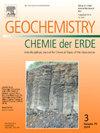Сomposition,乌拉尔褶皱带碳酸岩杂岩中铌稀土矿化演化及成矿时代:成矿学新认识
IF 2.9
3区 地球科学
Q2 GEOCHEMISTRY & GEOPHYSICS
引用次数: 0
摘要
南乌拉尔地区伊尔梅诺-维什涅沃戈尔斯克(IVC)和布尔代姆(Buldym)碳酸盐岩杂岩是在海西碰撞造山运动和吸合碰撞作用下经历构造演化的变形线状碳酸盐岩杂岩。铌、稀土矿床与乌拉尔碳酸岩杂岩有关。铌稀土矿化以焦绿石超群矿物、绢蓝石和独居石为代表。研究了其组成演化及其与碱性岩浆作用、伟晶岩和碳酸岩形成、岩浆后期(热碳)作用的关系。为了确定成矿阶段的年龄和持续时间,对矿物火绿石超群相和独居石进行了UPb定年。乌拉尔碳酸盐杂岩的焦绿族矿物以钙辉绿石、钠辉绿石和钾辉绿石为代表。富U-(Ta)的焦绿石I在中伏期早期岩浆阶段,即中央碱性带的杂岩和碳酸岩I中结晶。含Ta-(U)辉绿石II形成于晚岩浆期,形成于滑石质云母岩和云母伟晶岩中,并存在于维什涅夫戈尔斯克地块的爆炸碳酸岩角砾岩和碳酸岩II中。这两种火绿石都具有岩浆特征——振荡带、a位无空位、低Nb/Ta <;80。焦绿石III和含sr - ree的焦绿石IV -具有高Nb/Ta >;300和氟(4-5 wt%),是由IVC云母岩侵入体和白云石晕中的碳酸盐岩II以及Buldym杂岩的碳酸盐岩III和白云石中的流体饱和含f碳酸盐岩体系形成的。稀土矿物—绿绢石(Ce)和独居石(Ce)形成于布尔迪姆杂岩的碳热岩和云母岩块的云母晕中。焦绿石组成的形态特征和演化表明矿石过程具有多成因性质,其低温晚期不仅与铌矿有关,而且与稀土矿化(斑绢石、独居石)有关。通过对焦绿石和独居石组矿物的u - pb测年,可以区分乌拉尔南部碳酸盐岩杂岩的两个成矿阶段。早期由Potanino矿床I型碳酸盐岩(378±5 Ma)中富U-(Ta)辉绿石记录,可与形成大陆边缘裂谷期(D3) IVС碱性岩和碳酸盐岩的初生结晶有关。而后期则为~ 255-230 Ma,主要产自Vishnevogorsk矿床的焦绿石II- iv(在滑石质云母岩、正长岩和云母伟晶岩中),以及不同矿带(P3-T2)的碳酸盐岩II,以及Buldym杂岩的碳酸盐岩III和碳热岩(~ 245-235 Ma, T1-2)中的焦绿石和单氮石。晚期成矿阶段与乌拉尔碰撞期及碰撞后松弛期古生代碳酸盐岩杂岩转化的复生—交代作用、含矿流体饱和碱性和碳酸盐岩熔体及流体的形成有关。本文章由计算机程序翻译,如有差异,请以英文原文为准。
Сomposition, evolution and age of Nb-REE mineralization in carbonatite complexes in the Ural Fold Belt: New insight into metallogenesis
The Ilmeno-Vishnevogorsk (IVC) and Buldym carbonatite complexes of the Southern Urals are deformed linear-type carbonatite complexes that underwent tectonic evolution as a result of accretion-collision processes and the Hercynian collision orogeny. The deposits of niobium and rare earth elements are associated with the Ural carbonatite complexes. Nb-REE ore mineralization is represented by the pyrochlore supergroup minerals, aeschynite and monazite. Their compositional evolution and connection with various phases of alkaline magmatism, pegmatite and carbonatite formation, and late postmagmatic (carbothermal) processes were studied. To determine the age and duration of the ore-forming stages, U![]() Pb dating of minerals pyrochlore supergroup phases and monazite was carried out. The pyrochlore-group minerals of the Ural carbonatite complexes are represented by calciopyrochlore, rarely natropyrochlore, and kenopyrochlore. Pyrochlore I, rich in U-(Ta), crystallizes in the earliest magmatic phases of the IVC, in the miaskites and carbonatites I of the Central Alkaline Band. In contrast, Ta-(U)-bearing pyrochlore II is formed in the later magmatic phases, in the taxitic miaskites and miaskite-pegmatites, and is present in explosive carbonatite breccias and carbonatites II of the Vishnevogorsk massif. Both varieties of pyrochlore have magmatic characteristics – oscillatory zoning, absence of vacancies in the A-site, and low Nb/Ta <80. Pyrochlore III and Sr-REE-containing pyrochlore IV – with high Nb/Ta >300 and fluorine (4–5 wt%), are formed from fluid-saturated F-containing carbonate systems in carbonatites II of the IVC miaskite intrusions and fenite halos, as well as in carbonatites III and fenites of the Buldym complex. REE minerals – aeschynite-(Ce) and monazite-(Ce) formed in the carbothermalites of the Buldym complex and in fenite halos of miaskite massifs. The morphological features and evolution of the pyrochlore composition indicate the polygenic nature of the ore process, the late low-temperature stage of which is associated not only with Nb but also with REE mineralization (aeschynite, monazite).
Pb dating of minerals pyrochlore supergroup phases and monazite was carried out. The pyrochlore-group minerals of the Ural carbonatite complexes are represented by calciopyrochlore, rarely natropyrochlore, and kenopyrochlore. Pyrochlore I, rich in U-(Ta), crystallizes in the earliest magmatic phases of the IVC, in the miaskites and carbonatites I of the Central Alkaline Band. In contrast, Ta-(U)-bearing pyrochlore II is formed in the later magmatic phases, in the taxitic miaskites and miaskite-pegmatites, and is present in explosive carbonatite breccias and carbonatites II of the Vishnevogorsk massif. Both varieties of pyrochlore have magmatic characteristics – oscillatory zoning, absence of vacancies in the A-site, and low Nb/Ta <80. Pyrochlore III and Sr-REE-containing pyrochlore IV – with high Nb/Ta >300 and fluorine (4–5 wt%), are formed from fluid-saturated F-containing carbonate systems in carbonatites II of the IVC miaskite intrusions and fenite halos, as well as in carbonatites III and fenites of the Buldym complex. REE minerals – aeschynite-(Ce) and monazite-(Ce) formed in the carbothermalites of the Buldym complex and in fenite halos of miaskite massifs. The morphological features and evolution of the pyrochlore composition indicate the polygenic nature of the ore process, the late low-temperature stage of which is associated not only with Nb but also with REE mineralization (aeschynite, monazite).
The results of U-Pb-dating of the pyrochlore- and monazite-group minerals make it possible to distinguish two stages of ore formation in the studied carbonatite complexes of the Southern Urals. The early stage is recorded by U-(Ta)-rich pyrochlore in carbonatites I, the Potanino deposit (378 ± 5 Ma), and can be correlated with the primary crystallization of the IVС alkaline rocks and carbonatites at the rifting stage (D3) of the forming continental margins. Whereas, the late stage is dated at ∼255–230 Ma yielded for pyrochlores II-IV of the Vishnevogorsk deposit – in taxitic miaskites, syenite- and miaskite-pegmatites, as well as carbonatites II of various ore zones (P3-T2), and pyrochlore and monazite – in carbonatites III and carbothermalites of the Buldym complex (∼ 245–235 Ma, T1–2). The late ore-forming stage is associated with palingenic-metasomatic processes of transformation of the Paleozoic carbonatite complexes and the formation of ore-bearing fluid-saturated alkaline and carbonatite melts and fluids at the Ural collision stage and post-collision relaxation.
求助全文
通过发布文献求助,成功后即可免费获取论文全文。
去求助
来源期刊

Chemie Der Erde-Geochemistry
地学-地球化学与地球物理
CiteScore
7.10
自引率
0.00%
发文量
40
审稿时长
3.0 months
期刊介绍:
GEOCHEMISTRY was founded as Chemie der Erde 1914 in Jena, and, hence, is one of the oldest journals for geochemistry-related topics.
GEOCHEMISTRY (formerly Chemie der Erde / Geochemistry) publishes original research papers, short communications, reviews of selected topics, and high-class invited review articles addressed at broad geosciences audience. Publications dealing with interdisciplinary questions are particularly welcome. Young scientists are especially encouraged to submit their work. Contributions will be published exclusively in English. The journal, through very personalized consultation and its worldwide distribution, offers entry into the world of international scientific communication, and promotes interdisciplinary discussion on chemical problems in a broad spectrum of geosciences.
The following topics are covered by the expertise of the members of the editorial board (see below):
-cosmochemistry, meteoritics-
igneous, metamorphic, and sedimentary petrology-
volcanology-
low & high temperature geochemistry-
experimental - theoretical - field related studies-
mineralogy - crystallography-
environmental geosciences-
archaeometry
 求助内容:
求助内容: 应助结果提醒方式:
应助结果提醒方式:


